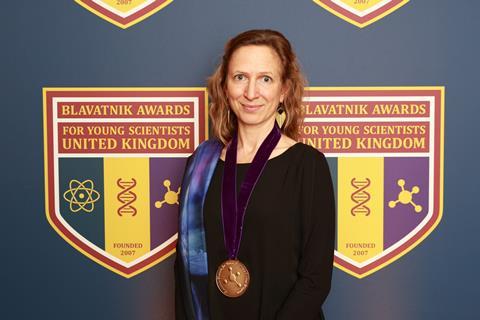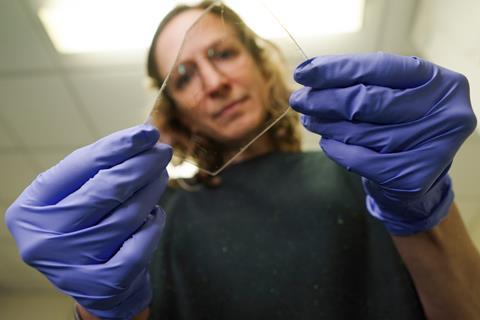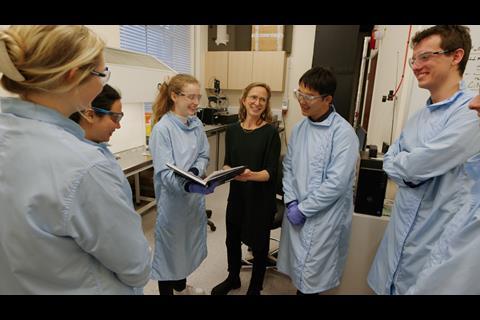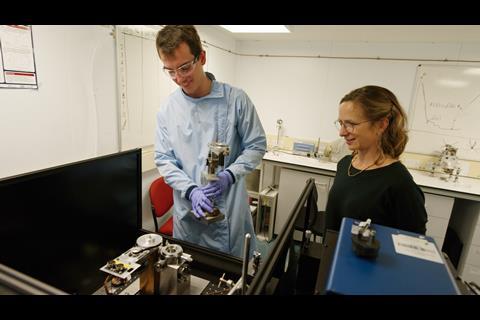There are only a few surface force balances in the world, and Susan Perkin’s group has one of them. ‘You can’t go and buy one,’ explains Perkin. Staff in the mechanical and electronic workshop in the University of Oxford’s chemistry department make all the components for the instrument Perkin works with.
Surface force balances confine liquids between two thin sheets of material. Perkin’s team typically makes these sheets out of a kind of clay called mica because it has a lamellar crystal structure, which means they can break it along its crystal plane to get two pieces that are atomically smooth and identical. The instrument uses light and a bending spring to measure the distance between those crystal faces with molecular resolution.
Measuring force as a function of distance gives the team a direct measure of the interaction energy, which can provide various insights into what’s going on at the liquid’s interface. ‘There are many, many, things that you can learn from it,’ says Perkin. ‘For example, we learn about the structure of the liquids, the way in which the ions are interacting with each other at the surfaces. If we apply an electric field, how do they move around? How does it vary over time? What happens if you add some extra molecules to change the surface? For example, making it hydrophobic.’
Perkin‘s team develops and modifies their surface force balance to study different things, collaborating with the workshop staff to tweak its optical and mechanical details. ‘Our version of this apparatus is about as high resolution as you can get. It’s beautifully made.’ She emphasises that having highly skilled workshop staff in the department has been crucial to her team’s work. ‘If we were working with a supplier somewhere outside of the city, the progress would be so slow, and when things go wrong in the middle of an experiment, we’d have no chance of actually rescuing that.’
They use their shoebox-sized surface force balance to study electrolytes, in particular electrolytes at interfaces. Understanding the structure, reactions and thermodynamic and kinetic behaviour at the interface between electrodes and electrolytes is essential knowledge for researchers attempting to develop batteries with enhanced performance. One iteration of Perkin’s team’s surface force balance uses graphene instead of mica, which allows them to study how electrolytes behave between graphene electrodes.1
Electrolyte decay
100 years ago, Peter Debye and Erich Hückel devised a theory to explain mathematically how the concentration of ions varies with distance from a surface. It said that the interaction between two charged particles or surfaces in an electrolyte decays exponentially as the separation distance increases. But earlier in her career, Perkin and her colleagues uncovered that when an electrolyte contains a high concentration of ions, around 0.1 molar and above, the Debye–Hückel theory fails.2 Instead, for concentrated electrolytes, ion charge density decays in an oscillating manner. Perkin clarifies that this decay pattern had already been predicted, but it wasn’t well known. Her team’s work was the first to show it experimentally.
Batteries use electrolytes with high concentrations of ions, but the layers created by this oscillating decay pattern can be detrimental to their performance. ‘If you want to store energy, ions have to be able to get to the electrode very easily,’ Perkin explains. Researchers designing battery electrolyte materials would therefore want to minimise the oscillations. ‘What we have shown in our subsequent experiments is how variations of concentrations and ion size and radius ratio and so on modify this damped oscillation. There are some conditions under which it’s minimal. And that is the sweet spot you would be looking for.’
Battery developers typically devise electrolytes with such features through trial-and-error, but they don’t necessarily know why it works, Perkin says. ‘We explain the physics, and when you understand something, it means that you can make it even better.’
Battery electrolytes aren’t the only electrolytes that Perkin investigates in her lab. Seawater, and physiological electrolytes such as cytosol, for example, contain ions at concentrations where there are knowledge gaps concerning their fundamental physical chemistry. ‘There are so many curious observations and unanswered questions in the world of electrostatics in condensed matter. And I feel that experiments are the right way to uncover the direction that we need to go in,’ she says.

Perkin was recently named the chemistry laureate of the 2023 Blavatnik Awards for Young Scientists in the UK. In particular, the award highlighted the experimental observations she has made using the surface force balance. ‘It makes me grateful for the team of students and postdocs that I’ve had good fortune to work with all this time, because nothing good would have come of the science if it hadn’t been for those conversations and dead ends we suffered together,’ she says. ‘I definitely feel humbled, because my name is there, but it’s really everybody.’



